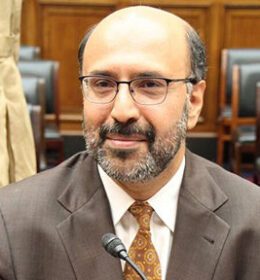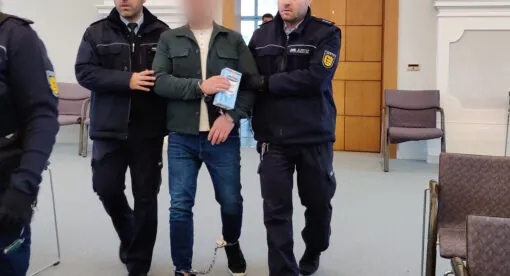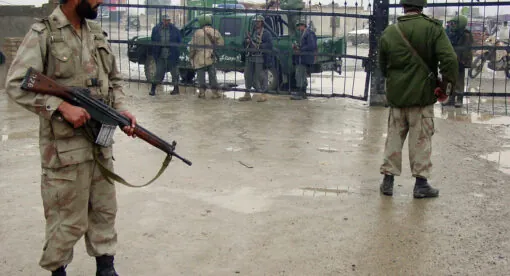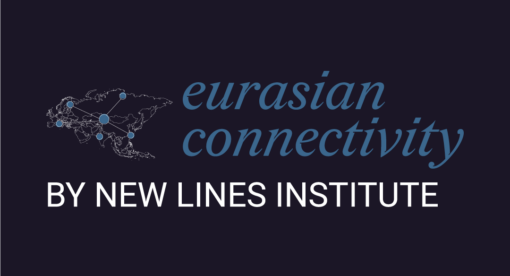The unprecedented global challenge posed by the COVID-19 pandemic is testing the resources and capabilities of government services. Law enforcement personnel, who are at the forefront in the fight against the disease and are among those at a high risk of becoming infected, have been particularly affected. The changes triggered by these challenges show that police institutions require major reforms to serve their communities better, including adopting new training curricula, establishing links between police and health institutions, investing more in community policing, fighting cybercrime, and increasing transparency in decision-making processes.
Examples of global pandemic-era crime trends from the United States, the United Kingdom, France, South Asia, and Singapore can provide lessons for practitioners and policymakers on how to prepare and invest in police institutions for better security and handling future threats. With shutdowns, travel restrictions and work-from-home limitations, reported crimes (such as theft and burglary) have declined considerably, but there has been a spike in domestic violence and cybercrime. The brutal killing of George Floyd at the hands of a police officer in Minneapolis added another layer of complexity to the situation as it galvanized anti-racism and anti-police protests across the United States and in several other countries. The full scope of the impact of the pandemic on crime and security is still unclear. Criminals have clearly adopted new ways to exploit the situation, and police have to be a step ahead of them to be effective. Police professionalism and resilience is going through a severe trial in the process.
A New Kind of Policing Challenge
COVID-19 compelled police forces across the world to alter their operational strategies and adjust their resources. In France, over 100,000 police and gendarmes patrolled streets to enforce lockdown and fine residents who left shelter without legal reason. Police stopped over 70,000 people and fined around 4,000 the first day of the lockdown. In Italy, police checked 700,000 citizens in just one week in March, over 40,000 of whom were in violation of regulations.
As is clear from these examples, police organizations had to focus on this new challenge at a time when awareness about the potential impact of COVID-19 was gaining traction very slowly. These efforts also occurred while many police forces were reporting absentee rates in the range of 20 percent due to officers either themselves falling ill with COVID-19 or self-quarantining. In the United Kingdom, retired Metropolitan police officers were asked to return to service to help deal with the crisis. In developing countries, inadequacy of resources and overwhelming responsibilities often hold them back from performing their duties efficiently. Mohammad Ali Babakhel, a senior Pakistani police officer, aptly explained the police dilemma in developing states by arguing that during crisis situations police are expected to perform multiple roles including conducting rescue operations, protecting of life and property, managing crowds, securing relief distribution, providing security for rescue camps, managing traffic, and coordinating with other agencies on the scene. For the pandemic specifically, police also had to apprehend people hoarding supplies, price gouging, and attempting to scam relief-seekers, as well as enforce social distancing protocols at religious gatherings. Expectations from police to deliver on all these counts without fulfilling their essential budget needs would only result in failures and frustrations.

A discernible and dramatic impact on crime figures since the COVID-19 pandemic began offers insights into how various criminal elements operate. In the United States, unreported domestic violence has emerged as a major concern for police organizations, a situation that worsened because of the closing down of many women’s shelters. French police recorded a 30 percent spike in reported cases of domestic violence. A New York Times report aptly refers to the rising cases of domestic abuse as “an opportunistic infection” thriving during the pandemic. A U.K. study, “Policing the Lockdown: Domestic Abuse and Vulnerability,” predicts calls to police will rise sharply in the post-lockdown phase when victims of domestic abuse will have more opportunity to reach out to police safely. It further argues that the financial and domestic stresses caused by the pandemic exacerbate tensions in these situations, leading to more violence. Effective police response in such cases requires understanding of the history of the abuse, the nature of the threat to the victim, and insight about the mental state and behavior pattern of the offender. This requires time and extra police resources, not only to investigate these cases but also to invest in learning more about the impact of the virus on populations.
In many Asian and African states, police forces are being redeployed from rural to urban centers for enforcing lockdowns as most social distancing violations were seen as occurring in densely populated city centers. However, as The Brookings Institution’s Vanda Felbab-Brown argues, this has made rural areas more vulnerable to crimes of opportunity and desperation. According to a United Nations Human Rights Commission report, criminal gangs in Honduras, El Salvador, and Guatemala are exploiting the COVID lockdowns to strengthen their control over various communities through “extortion, drug trafficking and sexual and gender-based violence, and using forced disappearances, murders, and death threats against those that do not comply.”
Cybercrime is on the rise as criminals exploit the opportunity created by the growing number of people who are going online for work, shopping, entertainment, etc. According to Allison Peters and Anisha Hindocha of Third Way, cybercrime “rates in the United States are estimated to have up to quadrupled during the COVID-19 pandemic.” The lethality of cybercrime is something that is not yet widely known. Web-based misinformation and disinformation, for instance, have created confusion, especially during the early phase of the pandemic. Russian and Chinese information operations compounded the situation as they waged disinformation campaigns seeking to sow suspicions about the United States’ handling of the crisis to deflect attention from their own struggles with the pandemic. By its very nature, cybercrime can extend beyond borders and jurisdictions, creating innumerable legal constraints and technological complexities in acquiring electronic evidence. Cyberspace is the latest ungoverned frontier that is being exploited for transnational crime, terrorism networking, and other criminal activity. Information sharing, both domestically and internationally, is a bigger issue in this case, as are specialized investigative skills and tools, and most police organizations lack resources or vision to tackle this problem effectively. Online harassment, hateful content, and sexual exploitation through social media is fast emerging as a serious issue, and this trend is more dangerous during the COVID-19 crisis.
The pandemic has forced law enforcement agencies across the globe to rely more on electronic means, ranging from surveillance cameras to facial recognition technologies and monitoring of online communications to use of artificial intelligence. Fighting crime requires these tools in some cases, but these are liable to be misused, jeopardizing civil liberties and serving as means for control and political manipulation.
One serious but under reported challenge pertains to police wellness in the midst of this crisis. As Jane Townsley, a former British police officer and currently executive director of International Association of Women Police, told this author in a recent Newlines Institute event focusing on global police reform, many junior police officials in South and East Asia are frightened due to the extremely difficult working conditions with insufficient PPE (personal protective equipment) to protect them and long working hours forcing them away from their families. Moreover, in many cases they have to suffer police leadership that is not supporting its personnel on the ground. Police-community relations also are likely to suffer during public health emergencies, and officers are “likely to develop symptoms of PTSD or depression.” Such developments can lead to mistakes and police excesses that can further erode public trust.
Best Practices
The European Union is considering a new approach to dealing with the coronavirus. Italy, Germany and Portugal are experimenting with partial or “smart” lockdowns — shutting down specific cities or areas to manage new outbreaks rather than enforcing nationwide lockdowns. This could be a more practical and sustainable solution for law enforcement, especially in states where new infections are relatively under control.
Efficient use of technology for targeted messaging in Denmark offers another interesting example. With the support of major telecommunications companies, the Danish National Police sent text messages to all mobile users in the country informing them about lockdown and social distancing regulations.

Singapore’s efforts to fight the spread of disinformation about COVID-19 offers important lessons. Benefiting from its 2019 Online Falsehoods and Manipulation Act, Singaporean law enforcement continuously monitored online content and prosecuted people who disseminated inaccurate information. It included dispelling the rumors about police intrusion in residential homes and excessive roadblocks to enforce safe distancing measures. It helped police reputation and served as a cautionary note that police performance is being watched.
Responding to the assessments about a spike in domestic abuse, the U.K. government announced a 76 million pound ($95 million) grant for survivors of domestic abuse and their children and created an official webpage providing guidance for survivors during the pandemic. Creating public awareness about redressal avenues and reporting procedures surely facilitates police work.
In Pakistan, while police forces served as the government’s primary tool to face the challenge, initiatives from civil society organizations also helped. For instance, an Islamabad-based group Corona Solidarity Campaign developed standard operating procedures for law enforcement handling of vulnerable populations as well as prisoners and shared these with the Ministry of Human Rights and police organizations.
In the United States, some police forces adopted flexibility, relaxing some standard law enforcement procedures. For instance, according to the Vera Institute of Justice, police departments in Miami-Dade, Rockford, Philadelphia, and Los Angeles relaxed arrest procedures for misdemeanor offenses and in some cases adopted cite-and-release policies for low-level offenses. One important purpose behind this strategy was to avoid incarcerating people to minimize the spread of COVID-19 in prisons and correctional facilities across the nation. Many departments expanded online and telephone reporting options for registering complaints or reports to minimize physical contact. For instance, the Burlington, North Carolina, Police Department issued a COVID-19 training bulletin advising police officers to use a Critical Decision Making Model, offering simple, step-by step-guidance for safe and effective outcomes during patrolling.

As U.K. scholar Dr. Ben Bradford articulates, “police activity experienced as procedurally just (respectful, open and accountable, explaining decisions and listening to people, making unbiased decisions, and conveying trustworthy motives) can motivate compliance, and does so in a way that is more sustainable and durable than the presentation of deterrent threat. Procedural justice enhances the legitimacy of the police and the wider justice system.” Police organizations following these basic principles of good policing are more likely to earn public trust, especially during challenging times. When asked about the key to policing success in tackling COVID-19 in Australia, Queensland Police Service Commissioner Katrina Carroll credited it to their “Three Cs Strategy: compassion, communication, and compliance.”
Emulating these best practices is not as simple as it may sound. In the well-articulated words of scholar Zoha Waseem about policing challenges in South Asia, “shifting towards a model of policing that puts empathy and compassion at its core demands that police officers unlearn their traditional techniques and methods. It requires cultural shifts within institutions.”
Recommendations
Policymakers and police organizations are advised to seriously consider:
- Developing standard operating procedures for police enforcement of lockdowns and social distancing, such as adjusting police rules during pandemics by reducing the number of police stops and volume of custodial arrests for minor offenses.
- Enacting laws that deal with emergency situations during the pandemic and incorporating checks on police powers to safeguard the rights of minority communities and especially underprivileged segments of society who are likely to be more vulnerable to exposure to the disease. Statistics from New York (for March and April) show that 93 percent of pandemic-related arrests involved people of color. Police must be held accountable to discourage such trends.
- Introducing changes in police training manuals and involving health experts (for instance from the U.S. Centers for Disease Control) in the faculty of police training schools. This will build police institutional capacity to tackle future pandemics.
- Establishing organizational links between health departments, experts on bioterrorism, and police institutions and developing credible channels of communication during public health emergencies. This would help streamline a long-term strategy to tackle pandemic-related crimes and facilitate joint exercises to improve preparedness for the future, enabling police institutions to play an active role in relaying national public health measures to citizens, in coordination with government organizations and health agencies, during health emergencies.
- Connecting local, national, regional, and international police communication networks to disseminate information rapidly and serve as a mechanism to create awareness as well as potentially to help with tracking individuals carrying the virus. This would also enhance police crime fighting capacity.
- Fighting cybercrime through domestic, regional, and international cooperation and equipping police forces with specialized investigative tools and transnational reach to respond effectively. This would assist police in addressing online disinformation campaigns endangering the citizenry and causing security issues.
- Joining the Budapest Convention, the only global cybercrime treaty, and following due process for cybercrime cases. This instrument serves as a guideline for any state developing legislation for fighting cybercrime and offers a valuable framework for international cooperation on the subject. Its additional protocol dealing with “criminalization of acts of a racist and xenophobic nature committed through computer systems” is equally important.

8. Updating and revising community and problem solving-oriented policing models by incorporating lessons learned during the pandemic. To quote Ron Davis, the former police chief of East Palo Alto, California, “We must reimagine policing so that it relies less on physical interventions and more on community partnerships.” Police excesses benefitting from emergency powers during pandemic (as recorded by the UN High Commissioner for Human Rights in 15 states) and heavy-handed responses to public unrest badly tarnishes a police department’s reputation and leads to an escalating spiral of violence and disorder, widening the gap between citizens and the police.
9. Emphasizing transparency in police decision making, especially in times of distress and public health emergencies. Public information sharing, especially during crisis situations, promotes trust building and inculcates a sense of security. Crisis management training manuals for police leadership must be adapted accordingly to institutionalize transparency as it ensures procedural fairness and strengthens accountability. This would hopefully take care of concerns about securitization of public health emergencies.
10. Ensuring that police personnel have sufficient supplies of PPE and other necessary equipment for operating during public health emergencies, including dealing with bioterrorism scenarios. Without such support, police effectiveness is likely to be seriously compromised.
Dr. Hassan Abbas is a Senior Fellow at the Newlines Institute and a distinguished professor of international relations at the Near East South Asia Centre for Strategic Studies at the National Defense University (NDU) in Washington, D.C. He Tweets at @watandost.
The views expressed in this article are those of the author and not an official policy or position of Newlines Institute, NDU, or the U.S. Department of Defense.







